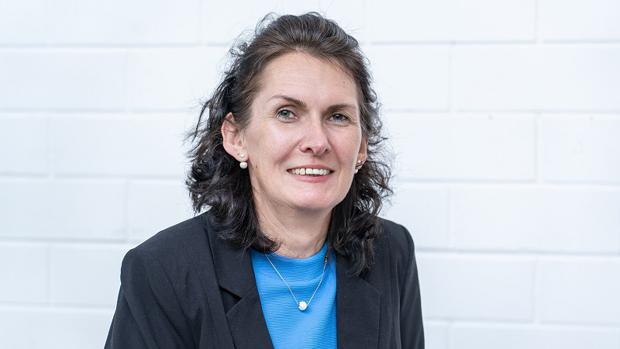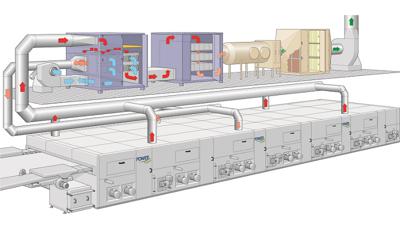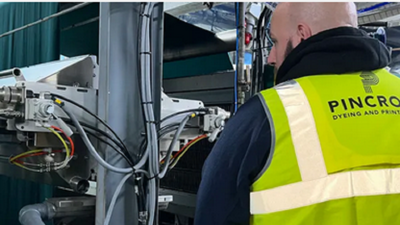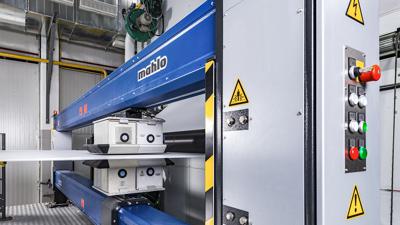Technical Textiles 1/2023

Dr. Heike Illing-Günther (Source: STFI)
We live in times of dramatically rising energy prices, possible shortage of energy sources and a growing environmental awareness on the part of both entrepreneurs and consumers. Therefore, the trend in the textile industry towards modern, ecological, energy and cost-efficient processes is intensifying at the moment. The proliferation of gas and electricity prices is pushing both companies and citizens to the limit.
In companies in the textile industry, the share of energy costs for drying/curing coatings now amounts to far more than 25% in relation to turnover. The pressure towards alternative, energy-saving, but also space-saving technologies is correspondingly high. UV curing is a drying technique that is already widely used in the coating, printing and paper industries. The use of UV-curable coatings for application on various materials is an environmentally friendly and energy-efficient alternative to traditional thermal drying or curing processes. The main advantages are the short process time due to fast curing at room temperature (a split second to a few seconds), the low energy and space requirements of the aggregates and the use of water and solvent-free 100% formulations. Energy savings of up to 75% are possible compared to classic thermal curing. However, classic UV mercury medium pressure lamps are still predominantly used as radiation sources in the industries mentioned.
In addition to many advantages, this radiation source is also associated with environmental and occupational safety issues, such as the toxicity of the mercury and the ozone forming during operation that affects the climate. UV LED lamps are a modern alternative source of radiation. These emit a narrowband and high-intensity spectrum, exclusively in the UV-A range (315-400 nm). Consequently, neither ozone is formed nor additional IR radiation is emitted, so that work is very gentle on materials. Further advantages are the long service life of the lamps (50,000 h), the infinitely variable dim-ability from 100 to 0% and that the lamps do not require any ramp-up time after switching on. Therefore, fast on-off operations are possible. UV crosslinking is based on photo-initiated radical polymerization. The formulations consist of the active components’ binder and photo-initiator and optionally reactive diluent and crosslinker. The main properties of the crosslinked product are determined by the basic chemical structure of the binder. Epoxies, polyesters, polyethers, polysiloxanes, polyurethanes and polyacrylates are predominantly used as backbones.
At the Saxon Textile Research Institute (STFI), the possible applications of UV crosslinking are being investigated in the areas of textile coating, 3D printing by means of dispensers on textiles and as a matrix material for fiber reinforced composites.
In addition to many advantages, this radiation source is also associated with environmental and occupational safety issues, such as the toxicity of the mercury and the ozone forming during operation that affects the climate. UV LED lamps are a modern alternative source of radiation. These emit a narrowband and high-intensity spectrum, exclusively in the UV-A range (315-400 nm). Consequently, neither ozone is formed nor additional IR radiation is emitted, so that work is very gentle on materials. Further advantages are the long service life of the lamps (50,000 h), the infinitely variable dim-ability from 100 to 0% and that the lamps do not require any ramp-up time after switching on. Therefore, fast on-off operations are possible. UV crosslinking is based on photo-initiated radical polymerization. The formulations consist of the active components’ binder and photo-initiator and optionally reactive diluent and crosslinker. The main properties of the crosslinked product are determined by the basic chemical structure of the binder. Epoxies, polyesters, polyethers, polysiloxanes, polyurethanes and polyacrylates are predominantly used as backbones.
At the Saxon Textile Research Institute (STFI), the possible applications of UV crosslinking are being investigated in the areas of textile coating, 3D printing by means of dispensers on textiles and as a matrix material for fiber reinforced composites.
In the field of textile coating, various formulations are being developed to create soft, stretchable and flexible layers. Functions such as light fastness, flame retardancy, abrasion resistance, thermal insulation, antimicrobial effect and color/optical effects can be achieved by incorporating special additives. The formulations are applied by knife coating (direct or transfer process), reverse roll coating, spraying or padding. In addition to UV-curable 100% systems, water-based formulations are also used in which drying takes place thermally and crosslinking is UV-induced. The energy savings of the overall process are correspondingly lower, but established, existing technologies and processing lines can be used.
Based on the results of full-surface textile coating with UV-crosslinkable formulations, the advantages are combined with those of additive manufacturing (3D printing). In this process, textiles are partially functionalized with dispenser printing and the print is simultaneously crosslinked using UV LED spotlights. The basis is the same formulations as for full-surface coating, but the rheological properties have to be adapted to the printing process. In the production of fiber reinforced composites, the curing of the resin matrix is the most time-consuming step. This is associated with long process times and low production rates. Usually, the curing process is carried out at temperatures between 70 and 180 °C and is thus additionally energy intensive. When using UV-curable matrices, the curing can be accelerated very much (seconds to a few minutes) and take place at room temperature.
In summary, UV crosslinking is an alternative to classic drying and crosslinking technology with a wide range of application fields in the textile industry.
However, it is also true that innovations need to mature, as do the decisions of the industry in new plant concepts and technologies. Also, future investments need expectable framework conditions. There is no more time for political discussions; companies need a perspective, including a reliable, predictable and transparent energy market.
Dr. Heike Illing-Günther
Managing Director
Saxon Textile Research Institute (STFI)
Chemnitz/Germany
Managing Director
Saxon Textile Research Institute (STFI)
Chemnitz/Germany



